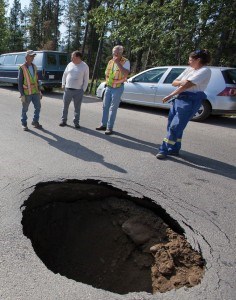
Although it’s no secret that Jasper’s infrastructure is beginning to age beyond its useful life, a recent study has revealed to what extent the municipality has fallen behind in its repairs and replacements.
According to the Strategic Asset Management Study that was completed by Pillar Systems Inc., the municipality is carrying an annual infrastructure deficit of about $3.3 million.
In layman’s terms, that means each year there are about $3.3 million worth of maintenance and rehabilitation projects that aren’t being completed on the town’s roads, pipes, wells, facilities and vehicles.
Although that’s seems like a huge dollar figure, Pillar Systems’ Gordon Molnar assured council that it’s a manageable deficit.
“I don’t think there’s any panic in the state of the infrastructure here,” he said during the Oct. 20 regular council meeting. “It’s all manageable, but revenue increases, I’m quite certain, will have to happen to catch up to that infrastructure deficit.”
Currently the municipality is spending about $2.5 million a year on fixing, restoring and renewing its infrastructure assets.
To address the deficit, it would have to raise taxes by 16 per cent, utility rates by 28 per cent and culture and recreation user fees by 61 per cent.
“Now, there’s no panic around that because these sudden increases are not typically required,” said Molnar. “You can do it in a more softer, manageable approach. In order to take that softer, more manageable approach, part of the trick in moving forward is getting a better understanding of your infrastructures.”
Molnar’s study, which provides a high level look at the municipality’s infrastructure assets, was the first step in creating an asset management plan that the municipality can use to develop a long range funding plan that will help it attain infrastructure sustainability.
The next step is for the municipality to assess the condition of its assets.
That will cost the municipality a quarter million dollars, with the majority of those funds going toward sewer photography to determine the theoretical service life of the town’s underground pipes.
Molnar recommended the municipality undertake that assessment next year.
“Moving forward into 2016, what we’re proposing is maybe you take a look at your infrastructure in a little bit more detail, starting first with your roads and pipes, doing that condition rating assessment and doing the lifecycle optimization model.”
From there, he recommended that the municipality develop a multi-year budget based on the results, determining what assets to repair and when.
“The purpose of asset management, in essence, is to save you money,” explained Molnar. “There isn’t enough money available to just throw at infrastructure, so we have to do something a bit smarter with our assets.
“The trick in asset management is not fixing the worst first. The worst first is always expensive—you take one project and it can suck all of your capital resources, or you can take that same funding and spread it out to 20 things that need some sort of fixing before they become bad and, if you put your money there and prevent those moderate condition things from becoming extreme, you’ll get a lot greater value out of your dollar than if you put the worst first.”
Molnar said it’s all about undertaking preventative maintenance projects to reduce the number of major failures and breakdowns.
“Instead of looking simply at just replacement at the end of that service life, there’s ways of actually doing things in a preventative maintenance fashion.
“If you know the condition and what’s to be expected down the road, that effects what you do today and you can prevent an expensive thing from happening 20 years from now by addressing that thing today.
“You head off some of those expensive things before they become a problem.”
Jasper’s infrastructure deficit isn’t a unique problem; towns and cities across the country are struggling to keep up with their crumbling roads, pipes and facilities.
The problem was created when the federal government started increasing the responsibility of municipalities to build, own and maintain infrastructure, without providing adequate funding to do the job.
The consequences of this are seen in communities across the country, with potholes in the streets, waterline breaks underground or overflowing storm drains.
Talk of Canada’s growing infrastructure gap has been going on for more than 20 years and, since the late 90s, the National Research Council has been promoting asset management plans as the way forward.
Council recognized this and included the creation of an asset management plan as one its strategic priorities following the 2013 municipal election.
Nicole Veerman
[email protected]
